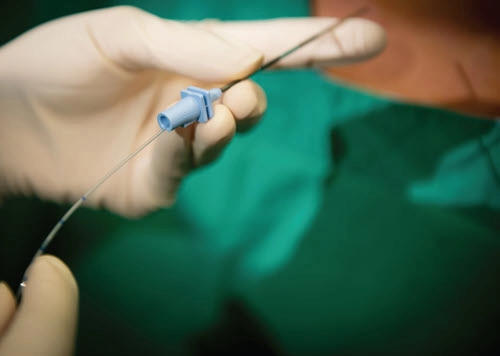Watch your modifiers for correct accountability – and don’t forget GC.
It’s not uncommon for several anesthesia professionals to be involved in a patient’s care, especially when cases are complicated or when an anesthesiologist routinely medically directs or medically supervises other providers. Use the following scenarios as examples to keep your own claims on the right payment track – by starting with correct documentation of providers.
Keep the Modifiers Straight
Whether you’re reporting care by an anesthesiologist, certified registered nurse anesthetist (CRNA), or anesthesia assistant (AA), each person’s involvement is typically reported separately and with the applicable modifier that also notes medical direction/supervision status. Typically, as there are still a few insurance companies that do not require or accept medical direction modifiers as recognized by the Center for Medicare & Medicaid Services (CMS). The choices are:
See How They Work in the Real World
Special guidelines apply to when and how you report some of these modifiers, particularly the ones related to medical direction and medical supervision (known as the 7 Rules of Medical Direction). Consider these examples from Kelly D. Dennis, MBA, ACS-AN, CAN-PC, CHCA, CPMA, CPC, CPC-I, owner of Perfect Office Solutions in Leesburg, Florida, to illustrate when you need to use modifiers to clarify which providers played a role in the case.

Scenario 1: Anesthesiologist and CRNA work together. Your providers offer kyphoplasty in the office setting. The physician performs the lumbar kyphoplasty and the CRNA administers anesthesia.
Code it: The anesthesiologist will report the correct procedure code(s) for the kyphoplasty as 22514 (Percutaneous vertebral augmentation, including cavity creation (fracture reduction and bone biopsy included when performed) using mechanical device (eg, kyphoplasty), 1 vertebral body, unilateral or bilateral cannulation, inclusive of all imaging guidance; lumbar) for the first level and +22515 (Percutaneous vertebral augmentation, including cavity creation (fracture reduction and bone biopsy included when performed) using mechanical device (eg, kyphoplasty), 1 vertebral body, unilateral or bilateral cannulation, inclusive of all imaging guidance; each additional thoracic or lumbar vertebral body (List separately in addition to code for primary procedure)) for each additional level treated. The CRNA will report the anesthesia with 01936 (Anesthesia for percutaneous image guided procedures on the spine and spinal cord; therapeutic). You will not report a medical direction/supervision modifier for the anesthesiologist because a physician cannot personally perform a procedure while medically directing or supervising a CRNA. You should, however, append modifier QZ to the CRNA’s claim.
Scenario 2: Unexpected cases added to the load. Three CRNAs from your group are working on separate cases under the anesthesiologist’s medical direction. An emergency patient comes in, and the anesthesiologist is called over.
Coding: The answer for this situation depends on whether the anesthesiologist’s involvement in the emergency case was of “short duration” and whether he remained in the immediate area.
Here’s why: CMS states that a medically directing anesthesiologist can perform certain other services concurrently and retain his or her medical direction status. One example is “Addressing an emergency of short duration in the immediate area.” If so, the anesthesiologist is still medically directing the CRNA cases and should report his participation in the cases with modifier QK. Submit each CRNA’s claim with modifier QX.
If the emergency case took more of the anesthesiologist’s time and he is not available to the medically directed CRNAs, he can no longer be considered as medically directing their services.

Another point: Remember that an anesthesiologist can only medically direct up to four concurrent cases. “If the anesthesiologist is medically directing four cases and takes another case – such as the emergency patient in the above scenario – it doesn’t matter whether the additional case is of short duration,” says Dennis. “It becomes a fifth case, moving the anesthesiologist’s role to medical supervision instead of medical direction, meaning you should append modifier AD to the claim.”
Once the anesthesiologist’s status shifts to medical supervision, he cannot bill for any of his involvement in the cases he initially medically directed. Depending on the insurance and documentation, submit the claims for the CRNAs with modifier QZ.
Scenario 3: Filing claims with multiple payers. The anesthesiologist medically directs three cases in which one payer is Medicare and the others are private insurers.
Coding: When it’s time to calculate concurrencies, all payers’ cases go into the mix – not just Medicare’s. Include every case when determining whether to report the anesthesiologist’s service as medical direction or medical supervision, even if you might not report the concurrency modifiers to all payers.
Don’t Forget the Teaching Modifier
If you code for anesthesiologists who help train residents in a teaching facility, there’s one more provider modifier to keep on your radar: GC (This service has been performed in part by a resident under the direction of a teaching physician). This modifier comes into play when a resident assists a physician in a teaching hospital.
Know the rules: When the anesthesiologist works as a “teaching physician” (TP) and supervises a resident’s services in a clinic or hospital setting, you must report your physician’s work using the TP rules, according to the Medicare Carriers Manual (MCM), section 15016.
The MCM defines a resident as an intern or fellow who’s enrolled in an accredited graduate medical education (GME) program.
Important: Modifier GC does not only apply to E/M codes. The modifier indicates that a resident provided the procedure under a teaching physician’s direction. Reporting modifier GC also indicates that the teaching physician was present for the entire procedure – or present for the key and/or critical portions of the procedure and immediately available for the rest of the procedure (such as present in the operating suite).
